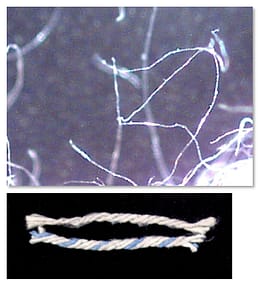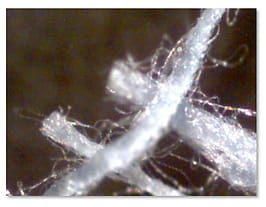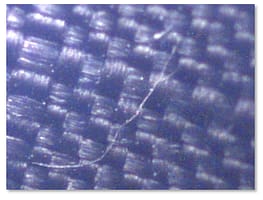
It’s winter again; and that perennial problem of fiber contamination is, once more, a major headache in the paint shop.
This time of year, complaints of fiber shedding and ruined paint jobs are on the rise, but laying the blame on the filter system may be focusing on the wrong culprit. Whether or not the filter system, in a given operation, is the most elaborate available may have little to do with an increase in fiber contamination.
Now, let’s admit it; blaming the filter is a common enough occurrence in most painting operations and in a few cases may be absolutely correct. Not in most, however. What! It’s not the filters’ fault? Well then why are these fibers, that to the naked eye sure look a lot like filter fibers, showing up all of a sudden?

This knee-jerk reaction to point a finger at filters happens all the time. Most spray booths do have a large amount of filter surface area in both the supply and exhaust air systems, but are these the only sources of fibers? And, why is it such a problem now?
One commonly overlooked instigator of increased fiber contamination is the lack of humidity. During the spring, summer and fall, most areas of our country enjoy a relatively moderate to high level of humidity. In the winter, however, Mother Nature starts operating her refrigerated drying system. Humidity levels can drop from as high as 70%, or higher, to as low as 20%, or even lower. The net effect is drier air.

One might see this more easily when walking across a carpet and getting a surprise shock when grabbing a doorknob or other grounded object; but in a paint shop, or any cleanroom for that matter, this manifests itself in more random fibers floating around in the air. Fibers that may have remained affixed to any flat surface for several months may now become airborne due to the reduction of humidity in the atmosphere of the paint shop.
Where did these fibers originate? Look around the shop. What sources of fibers are in, or around, the spray booth? Wipe clothes, buffing pads, painters’ clothing and vehicle parts are all sources of fiber attrition that can eventually find their way into the paint job.

When spray booth doors are open, especially in non-pressurized spray booths and pressurized booths when the fans are not in operation, fibers can and will infiltrate the booth. The dry air increases the likelihood that these fibers will remain airborne and eventually find a way to become part of that beautiful paint job.
All is not lost. There are ways of minimizing the impact of dehumidified air. The most important way, short of a humidity-controlled environment, is a tightly controlled process and a common sense approach.
First, keep the doors to the spray booth closed unless loading or unloading parts. When doing so in a pressurized spray booth, keep the fans on the booth in operation so a minimum of pressurization can be maintained.
Why?
All spray booths have an exhaust system. When the fans are off, the exhaust stack damper remains partially open. This is part of the design to prevent the accidental build-up of VO’s or other noxious vapors. This creates an updraft of air that continually pulls air through the spray booth and is commonly referred to as a chimney effect. When the booth doors are open, these small drafts of moving air will carry paint damaging particulate, especially fibers, into and through the booth where they may become a source of contamination.
Second, ensure that all personnel are properly clothed with lint-free garments while in the spray booth, AND ensure that those lint-free garments are not worn outside of the spray booth to perform other tasks. If at all possible, install a changing room attached to the booth or use an attached paint mix room for this purpose.
When these garments are worn inside of the spray booth, the air passing across the surface creates a mild static charge that will make it a magnet for every piece of lint or fibers close enough to attach. A black light will provide you with a sufficient amount of evidence to this effect.
Third, housekeeping is often overlooked as a source of contamination. Not that it should not be performed, but when doing so, use lint-free wipe cloths to clean spray guns, hoses and equipment such as worktables within the booth. Dragging hoses across a dirty floor can create airborne contaminants as well. Vacuum the floor if the type of coating permits, or clean the floors with lint-free mops to remove excess debris and overspray build-up.
Fourth, using compressed air to blow off the parts within the spray booth prior to painting is going to liberate a sufficient amount of contamination that could damage paint jobs all day. Prep stations are the best place to do this operation; but if it’s done inside the booth, give the booth about an hour or so of run time to change out the air through the filters and hopefully remove the contamination. Then tack off the parts prior to painting.
Fifth, if there is a buffing operation or wet sanding operation within the same general area, try to isolate the operation by using curtains and by pressurizing the painting area with an air make up system. The important thing to remember is that knowing and understanding the air movement within a shop is a critical part of a good process. If air movement is toward the spray booth, then problems with these contaminant sources are more than probable.
Can the filters be a source of fiber shedding?
The binders used to hold fibers together are sufficiently strong in most filter media available for use in a paint operation that fiber attrition is most unlikely, but possible.
If the fibers can be examined under a microscope at 250 – 400 times magnification, sufficient details regarding the structure of fibers can be seen and comparisons can be made to identify like fibers. There are differences in the shape of the fiber diameter (round, oval, flat, rectangular, square, etc.), the length of the fiber, coloration, and other characteristics between clothing fibers, wipe cloths, buffing pads, filters, etc, that will help determine like or unlike sources of contamination.
Chasing the sources of contamination can be frustrating at best.
One of the best ways to highlight your business is through a story that you can share across your online platforms. It humanizes your business and shows that your business can make a meaningful impact. Your testimonial would be used as a project profile on the GFS Booth Blog and can be shared on your website and/or social media channels.
Complete this form and we’ll be in touch to showcase your company.

Shop a variety of GFS aftermarket products, including booth protection products and mobile accelerated curing units. And enjoy the convenience of fast and free ground shipping throughout the contiguous United States.

Located at GFS’ headquarters in Osseo, Wisconsin, the Center for Excellence is an innovative facility featuring an automotive refinish training center, as well as a separate space dedicated to technical product training.

GFS is continuously searching for talented, ambitious individuals to join our team. We aim to provide our employees with every opportunity to make an impact on the company and find their niche along the way — weather in a production, field services or an office position.